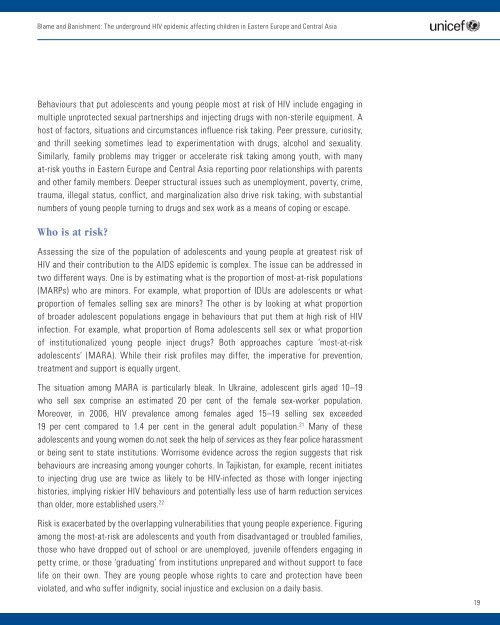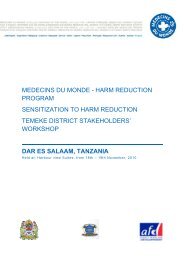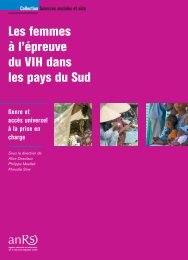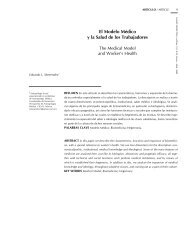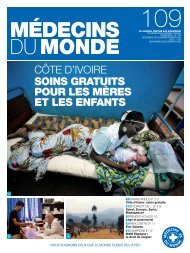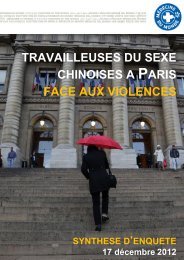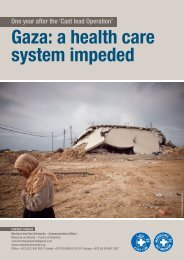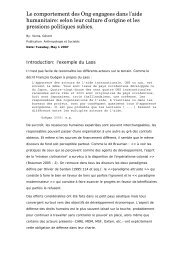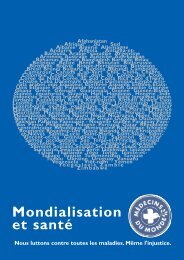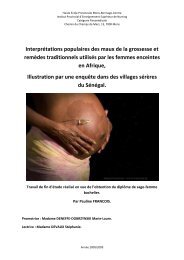Blame & Banishment - Médecins du Monde
Blame & Banishment - Médecins du Monde
Blame & Banishment - Médecins du Monde
Create successful ePaper yourself
Turn your PDF publications into a flip-book with our unique Google optimized e-Paper software.
<strong>Blame</strong> and <strong>Banishment</strong>: The underground HIV epidemic affecting children in Eastern Europe and Central Asia<br />
Behaviours that put adolescents and young people most at risk of HIV include engaging in<br />
multiple unprotected sexual partnerships and injecting drugs with non-sterile equipment. A<br />
host of factors, situations and circumstances influence risk taking. Peer pressure, curiosity,<br />
and thrill seeking sometimes lead to experimentation with drugs, alcohol and sexuality.<br />
Similarly, family problems may trigger or accelerate risk taking among youth, with many<br />
at-risk youths in Eastern Europe and Central Asia reporting poor relationships with parents<br />
and other family members. Deeper structural issues such as unemployment, poverty, crime,<br />
trauma, illegal status, conflict, and marginalization also drive risk taking, with substantial<br />
numbers of young people turning to drugs and sex work as a means of coping or escape.<br />
Who is at risk?<br />
Assessing the size of the population of adolescents and young people at greatest risk of<br />
HIV and their contribution to the AIDS epidemic is complex. The issue can be addressed in<br />
two different ways. One is by estimating what is the proportion of most-at-risk populations<br />
(MARPs) who are minors. For example, what proportion of IDUs are adolescents or what<br />
proportion of females selling sex are minors? The other is by looking at what proportion<br />
of broader adolescent populations engage in behaviours that put them at high risk of HIV<br />
infection. For example, what proportion of Roma adolescents sell sex or what proportion<br />
of institutionalized young people inject drugs? Both approaches capture ‘most-at-risk<br />
adolescents’ (MARA). While their risk profiles may differ, the imperative for prevention,<br />
treatment and support is equally urgent.<br />
The situation among MARA is particularly bleak. In Ukraine, adolescent girls aged 10–19<br />
who sell sex comprise an estimated 20 per cent of the female sex-worker population.<br />
Moreover, in 2006, HIV prevalence among females aged 15–19 selling sex exceeded<br />
19 per cent compared to 1.4 per cent in the general a<strong>du</strong>lt population. 21 Many of these<br />
adolescents and young women do not seek the help of services as they fear police harassment<br />
or being sent to state institutions. Worrisome evidence across the region suggests that risk<br />
behaviours are increasing among younger cohorts. In Tajikistan, for example, recent initiates<br />
to injecting drug use are twice as likely to be HIV-infected as those with longer injecting<br />
histories, implying riskier HIV behaviours and potentially less use of harm re<strong>du</strong>ction services<br />
than older, more established users. 22<br />
Risk is exacerbated by the overlapping vulnerabilities that young people experience. Figuring<br />
among the most-at-risk are adolescents and youth from disadvantaged or troubled families,<br />
those who have dropped out of school or are unemployed, juvenile offenders engaging in<br />
petty crime, or those ‘gra<strong>du</strong>ating’ from institutions unprepared and without support to face<br />
life on their own. They are young people whose rights to care and protection have been<br />
violated, and who suffer indignity, social injustice and exclusion on a daily basis.<br />
19


